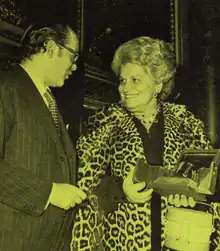Onorina Tomasin-Brion
Onorina "Rina" Tomasin-Brion (1919 Santa Giustina in Colle – 2002 Milan) was an Italian entrepreneur and business manager. She was also one of the first women to be awarded the Cavaliere del Lavoro, in 1972. [1][2]

Life
She was born in Santa Giustina in Colle,[3] in the Province of Padua, in 1919, into a family of merchants from the town who owned a haberdashery. In 1939, during a train journey to Castelfranco Veneto, she met Giuseppe Brion, a RadioMarelli worker, whom she married in the same year and moved to Milan.
In 1945, together with her husband and the engineer Leone Pajetta, she founded BP Radio (later Brionvega), a company specialized in the production of electronic and electrical components for radios, as well as complete radio sets with the Vega brand. Tomasin dealt with the marketing of the products, but after the sudden death of her husband in 1968, she took over the management together with her son Ennio, and he succeeded in the offices of president and chief executive officer . [4]
The radios and televisions produced by Brionvega, had great commercial success all over the world and became known for their particular design. The best designers of the time worked there such as Marco Zanuso, Richard Sapper, the brothers Achille, Livio, and Pier Giacomo Castiglioni, Mario Bellini and Franco Albini. Under her management, the company continued its path of growth and expansion throughout the 1970s. [5]
Tomasin-Brion received awards such as the Cavaliere del Lavoro (1972), the Dalla Gavetta Award (1973), the Umberto Biancamano National Award, and the Golden Ambrogino (1981).[1][3][6] She was a director of the Banca Cattolica del Veneto and vice president of the Lombard section of the National Federation of the Knights of Labour.[7][8]
From her marriage to Giuseppe Brion she had two children, Ennio and Donatella.[9][10][11]
She died in 2002, and is buried together with her husband in the San Vito d'Altivole cemetery. [12] The Brion family tomb was designed by the architect Carlo Scarpa.[13]
References
- "Brion Rina – Cavaliere del Lavoro".
- "L' AVANZATA DEI 'COLLETTI ROSA' IN ITALIA SONO QUASI TREMILA – la Repubblica.it". Archivio – la Repubblica.it (in Italian). Retrieved 2023-03-25.
- "Cavaliere del Lavoro". Palazzo del Quirinale. Retrieved July 19, 2023.
- Alfonsi, Maria Vittoria (1975). Donne Al Vertice Incontri Con Maria Vittoria Alfonsi (in Italian). Cappelli. OCLC 3748199.
- V. Castronovo (ed.), I Cavalieri del lavoro. Cent'anni di imprenditoria, Federazione nazionale dei Cavalieri del lavoro, 2001, pp. 583–584.
- "Medaglie d'oro e attestati a 67 «milanesi» benemeriti". Corriere della Sera. 7 December 1981. p. 7.
- "Benvenuti nuovo presidente della Cattolica del Veneto". Corriere della Sera. 25 June 1983. p. 10.
- "Rina Brion eletta vicepresidente dei cavalieri del lavoro lombardi". Corriere della Sera. 25 June 1983. p. 27.
- "Memoriale Brion | Bene FAI". fondoambiente.it (in Italian). Retrieved 2023-07-18.
- Gugliotta, Francesca (2022-08-12). "Brion Memorial donated to FAI". IFDM. Retrieved 2023-07-18.
- "Interview with the architect: Ennio Brion". Floornature.com (in Italian). Retrieved 2023-07-18.
- "Il sindaco che firmò la licenza edilizia alla Tomba Brion di Carlo Scarpa | Daniele Ferrazza" (in Italian). Retrieved 2023-03-25.
- Ferrazza, Daniele (2020-01-20). "Il sindaco che firmò la licenza edilizia alla Tomba Brion di Carlo Scarpa" (in Italian). Retrieved 2023-03-26.